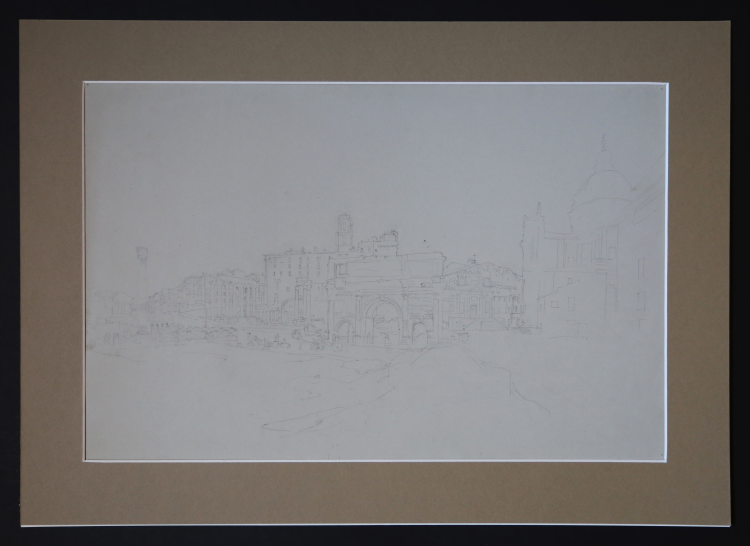




| Reference: | S36389 |
| Author | Felix BENOIST |
| Year: | 1864 ca. |
| Zone: | Foro Romano |
| Measures: | 465 x 305 mm |



| Reference: | S36389 |
| Author | Felix BENOIST |
| Year: | 1864 ca. |
| Zone: | Foro Romano |
| Measures: | 465 x 305 mm |
Black pencil drawing, mm 466x302.
Belongs to a collection of 127 works unearthed from a French antiquarian who, in turn, had acquired them from the heirs of publisher Henri-Désiré Charpentier (La Rochelle 1805 - Vertou 1882); they are all done in black pencil, some have white lead highlighting; they never bear the date and signature of the author, but only a brief caption relating to the subjects depicted. The drawings denote a skilled and expert hand - especially in the delineation of buildings, ruins and architecture - that restores the monuments of Rome from interesting and unusual perspective points. The reference of most of the drawings to some of the tinted lithographs by Felix and Philippe Benoist, published in the three-volume work Rome dans sa grandeur, immediately became clear. The fact that this is a large group of original drawings related to the famous work edited by Henri-Désiré Charpentier is clearly supported by the prestigious provenance; it is a part of Charpentier's heir fund, among which the material of the famous chalcographic workshop had been divided.
Rome dans sa grandeur. Vues, monument ancient et modernes was printed in Paris in 3 volumes, in 1870. The publication, illustrated by 100 lithographs, was preceded by a campaign of preparatory drawings, dating from 1864 until 1869, executed mainly by Félix Benoist and partly by Philippe Benoist. On the eve of the Concilio Ecumenico Vaticano I, on August 11, 1869, Pius IX decreed the creation of a Roman Exhibition of the works of every art executed for Catholic worship, which was inaugurated, on February 17, 1870, in the cloister of the Carthusian monastery of Santa Maria degli Angeli. On that occasion, the three folio volumes Rome dans sa grandeur were presented. The lavishly bound volumes, with the coat of arms of Pius IX stamped in the center in gold, are divided into three sections. The first volume deals with ancient Rome, the second, with Christian Rome, and the third, with the monuments and achievements of modern Rome. A valuable view of papal Rome on the eve of Rome's profound transformation into the capital of united Italy. A document that highlights the remarkable imprint left by Pius IX on the Eternal City. The work represents the French artist's masterpiece, so much so that it places Benoist among the ranks of the greatest artists of interiors and views of his time.
The sheets used for the preliminary studies vary in size (from 170 mm x 240 to 490 x 300 mm), weight and even color gradation (from beige to green). Many of the drawings undeniably represent different preparatory stages - more or less complete - of some of the dyed lithographs illustrating the magnificent work, others of the silographic vignettes included in the text, while other sketches do not find translation in print. Belonging to this second group are both sketches relating to monuments and views of Rome and its surroundings: ancient Ostia, Grottaferrata, Olevano Romano, Anzio, Nettuno, Velletri and Vicovaro. Far beyond from Rome are drawings relating to Naples and Loreto. The suite was to form part of the entire fund, later dispersed, of preparatory studies from which the hundred intended for lithographic printing were selected.
This drawing does not find a precise corresponding lithograph in Rome dans sa Grandeur, in which no less than four plates, from different perspectives, are devoted to the Forum Romanum in the first volume of the work, Rome Antique.
The perspective of this drawing is very similar to the table FORUM ROMANUM Colonne de Phocas Arc de Septime Sevére et Capitole and was probably a preparatory study for this table but in the drawing the point of view is from the area of the Curia Iulia, foregrounding the Arch of Septimius Severus.
“Ici encore nous retrouvons la main de Caracalla, grattant le nom de son frére.Cet acharnement fraternel ne fajt que mieùx lire le nom supprimé. L’arc de ' Sèvére est au pied du Capitole; il lui fuit érigé à lui et à ses fils, après ses victoires sur les Parthes, les Arabes et les Adiabenites. Cet arc, n marbre petélique et à trois ouvertures, est ornéde huit colonnes cannelées d’ordre composite et de bas-reliefs representant des scenes de guerre. Les voutes sont enrichies de caissons et de rosaces. Enfin sur la plate-forme, à laquelle on monte par un escalier de marbre pratiqué dans le coté occidental de l’arc, était la statue de Severe, entre celles de Caracalla et de Geta, sur un char tiré par six chevaux de front, entre deux fantassins et deux cavaliers” (Rome dans sa grandeur – Rome Antique, cap. II, p. 63)
|
Félix Benoist was a skilful and composed litographer and one of the most renewed French artists of landscapes in the 19th century. He printed many works together with Philippe Benoist, painter and lithographer born in Geneva in 1813, among which are: “Rome dans sa grandeur” a beautiful and thorough work on Papal Rome.
|
|
Félix Benoist was a skilful and composed litographer and one of the most renewed French artists of landscapes in the 19th century. He printed many works together with Philippe Benoist, painter and lithographer born in Geneva in 1813, among which are: “Rome dans sa grandeur” a beautiful and thorough work on Papal Rome.
|